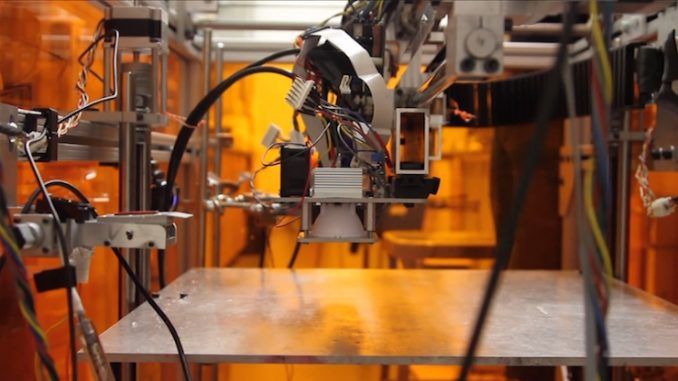
While most 3-D printers only print using one material, researchers at the Massachusetts Institute of Technology have created an incredible new kind of 3-D printer that can print using 10 materials at once. The MultiFab, as it is called, is inexpensive and can print out fabric, fiber-optics, and lenses.
CSMonitor.com reports:
Most 3-D printers use a single material to fabricate objects. For consumer 3-D printers, that generally means some kind of plastic or resin. But using only one kind of material means 3-D printers are limited in the kinds of objects they can create.

BYPASS THE CENSORS
Sign up to get unfiltered news delivered straight to your inbox.
You can unsubscribe any time. By subscribing you agree to our Terms of Use
There are 3-D printers that can use multiple materials, but they can cost tens or even hundreds of thousands of dollars, putting them out of reach for almost everyone besides engineers and developers.
A team at the Massachusetts Institute of Technology’s Computer Science and Artificial Intelligence Laboratory wanted to find a way to create a more affordable multi-material 3-D printer, and thus the MultiFab was born.
Most 3-D printers use a single material to fabricate objects. For consumer 3-D printers, that generally means some kind of plastic or resin. But using only one kind of material means 3-D printers are limited in the kinds of objects they can create.
There are 3-D printers that can use multiple materials, but they can cost tens or even hundreds of thousands of dollars, putting them out of reach for almost everyone besides engineers and developers.
A team at the Massachusetts Institute of Technology’s Computer Science and Artificial Intelligence Laboratory wanted to find a way to create a more affordable multi-material 3-D printer, and thus the MultiFab was born.
Traditional multi-material printers use a mechanical system to sweep each layer of the printed object after it’s laid down to ensure that it’s flat and correctly aligned. The extreme precision of such a system is a big part of the reason that printers are so expensive. But the MultiFab uses a machine-vision system instead of a mechanical one, which allows for precise scanning – down to 40 microns – without the need for so many pricey components, project engineer Javier Ramos told Wired.
The MultiFab team also developed a new 3-D scanner that can scan a large area quickly and in high resolution, even if the material being scanned is transparent. That allows the MultiFab to “understand” a variety of surfaces and materials. The printer uses printheads that can be purchased off the shelf, which makes it slightly less durable but much cheaper than other multi-material 3-D printers.
MIT’s new printer is an advance, but it isn’t able to print complex mechanical objects yet. Wired reports that a privacy screen for a smartphone can be printed in about an hour, but a small tire in multiple colors takes almost a day and a half to be fabricated. The MultiFab has trouble with shiny surfaces such as mirror finishes, although that difficulty can be alleviated with software improvements in the future.
Eventually, multi-material 3-D printers will be able to create complex objects in one pass, without needing to piece them together from component parts. “We want to combine materials that have functional properties either mechanically, which is what we’ve demonstrated, optically, or semiconducting,” Mr. Ramos told Wired. That would allow production designers, architects, and automakers to create full-color models of everything from movie sets to electric motors. The MultiFab may not be able to print complicated models yet, but it’s an important step in that direction.


